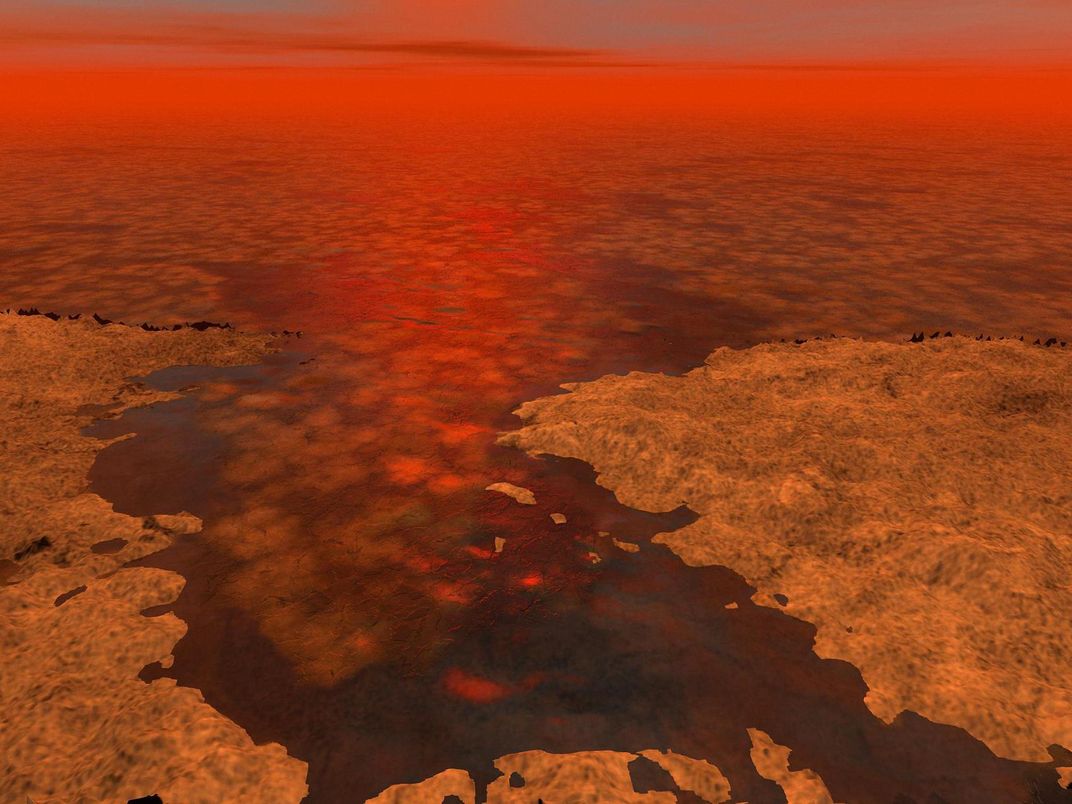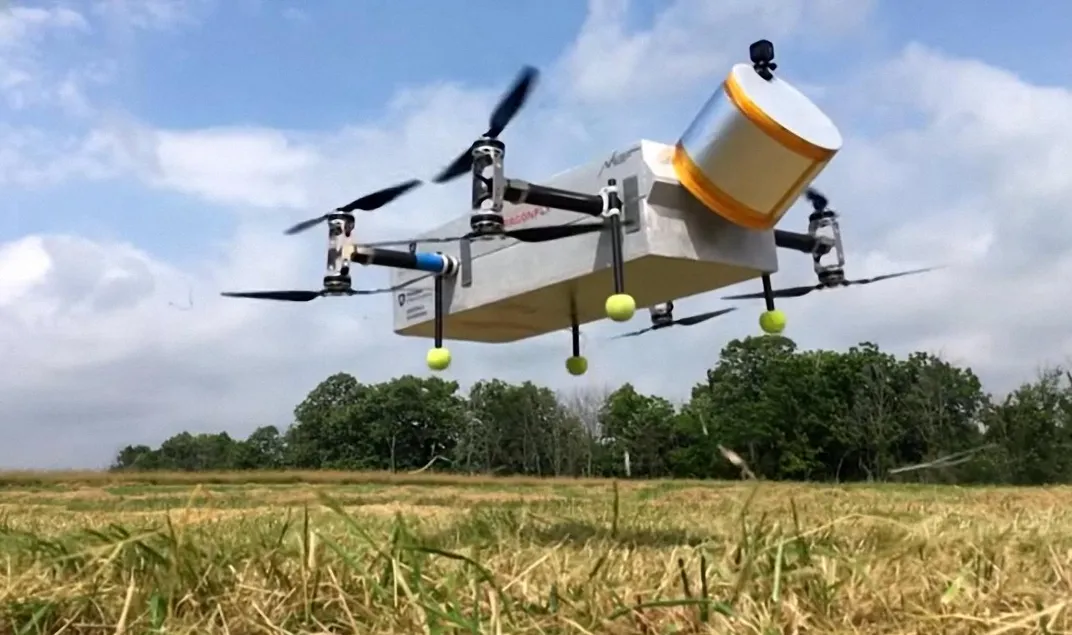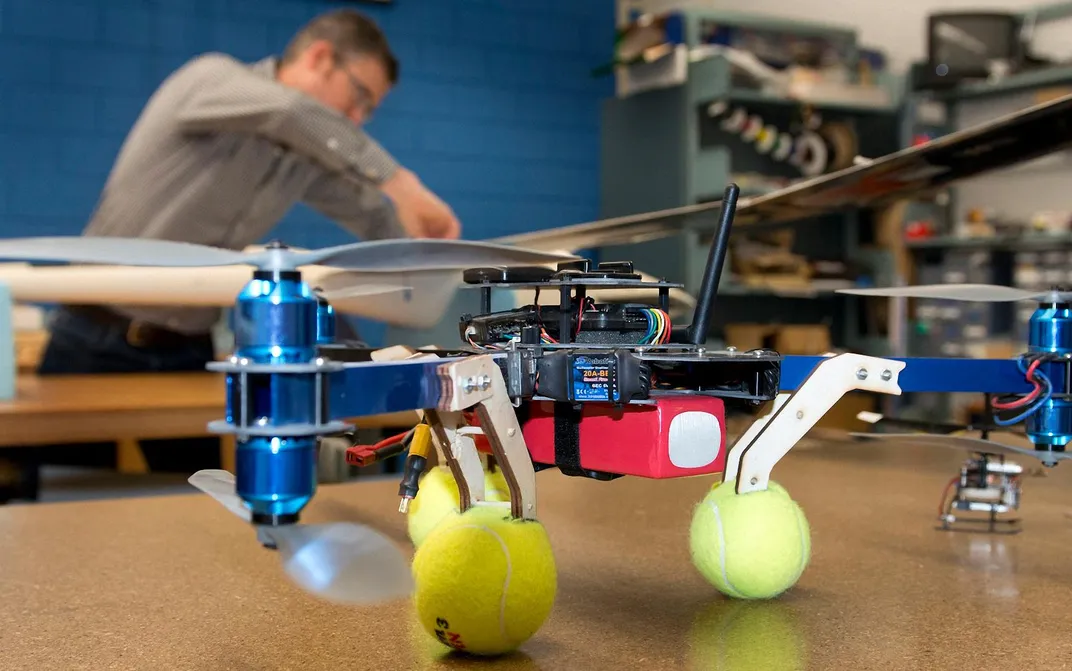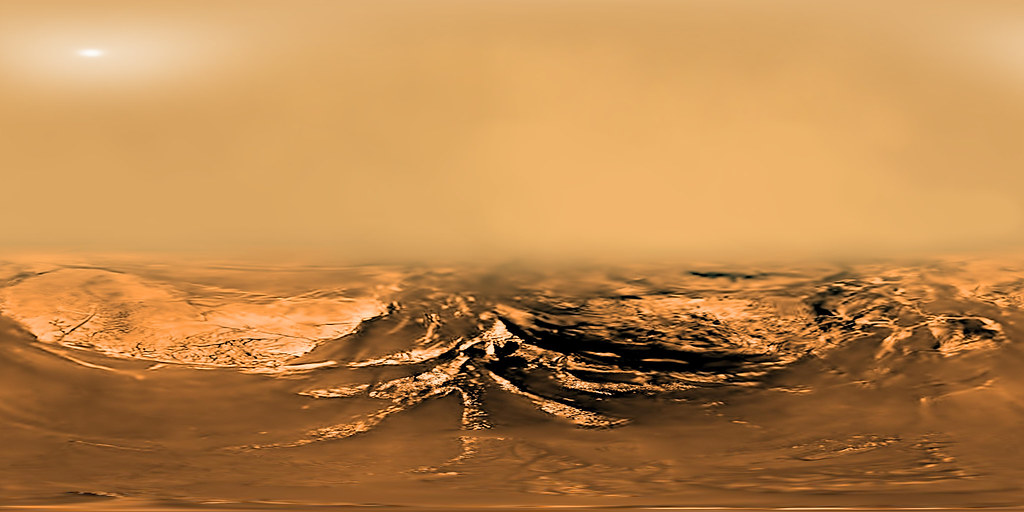Dragonfly Is the First Aircraft Built for the Outer Solar System
NASA returns to Saturn’s largest moon with a rover that can fly.
:focal(905x329:906x330)/https://tf-cmsv2-smithsonianmag-media.s3.amazonaws.com/filer/ab/5a/ab5a7e33-0d1e-40b5-be59-df9c6a4d8108/02j_sep2020_dragonflymissionhero_live.jpg)
The friendliest place to fly in this solar system isn’t here on Mother Earth. It’s on Saturn’s moon Titan, a mysterious world hidden by a methane-rich atmosphere four times denser than Earth’s. A team of Titan watchers sees opportunity in that dense atmosphere. It will enable them to explore a much larger area on Titan than rovers ever have done on Mars. The team is creating the Dragonfly mission, scheduled for launch in 2026, to investigate Titan with instruments carried not by wheels but propellers.
“The idea of flying on another planet is really exciting,” says Elizabeth “Zibi” Turtle, the principal investigator for the Dragonfly mission and a planetary scientist at the Johns Hopkins Applied Physics Laboratory (APL). “We’ve seen in the exploration of Mars how much mobility enhances the science return and what you can learn by going from place to place,” she says. “But on Titan we can take advantage of the atmosphere to fly from place to place rather than driving.”
Dragonfly, expected to weigh around 1,200 pounds, will be the size of the largest Mars rovers. Instead of resting on wheels, it will land on skids like a helicopter. Describing it as a “relocatable lander,” Dragonfly’s designers are relying on eight rotors in a quadcopter arrangement. At the end of each of its four arms, two 53-inch counter-rotating rotors, one atop the other, will provide lift.
Flying will give Dragonfly a level of mobility unmatched by any lander or rover ever built. The current otherworldly distance champion is the Mars rover Opportunity, which slinks along at an average of two miles per Earth-year. Dragonfly will cover that distance in minutes.
/https://tf-cmsv2-smithsonianmag-media.s3.amazonaws.com/filer/c3/ed/c3ed2ef8-4fc7-4ed7-8613-490fc9d68905/02e_sep2020_peoplezibiturtlensf06-27_2019_211848762finalsize_live.jpg)
For decades, Titan’s thick, orange-peach haze vexed astronomers who longed for a peek at the moon’s surface, but in that smog is a soup of prebiotic molecules that makes Titan all the more fascinating for study. NASA’s spectacular Cassini mission to Saturn, which spent 13 years exploring the gas giant and its 82 moons, measured the ingredients of Titan’s atmosphere, and found that it included organic compounds. Cassini’s analysis led to the belief that methane and ethane rain falls on Titan’s surface from clouds of chemicals in its sky. Turtle says this complex chemistry is a key to solving one of science’s biggest mysteries: How chemistry developed into biology.
“We can’t really study that on Earth because biology is everywhere, and it has overprinted its own origins,” she says. “Titan has all the same ingredients that early Earth would have had,” Turtle continues. “There’s energy in the form of sunlight. It drives photochemistry in the atmosphere by breaking down the methane, and the methane recombines to make exceedingly complex carbon molecules.”
Cassini’s radar and its Visible and Infrared Mapping Spectrometer, working in infrared light, finally lifted Titan’s vast veil. During periodic passes, Cassini photographed cloud movements in Titan’s atmosphere and used radar to peer beneath its haze to map the rich detail on its surface.
Cassini also deployed a lander—named Huygens after the Dutch astronomer Christiaan Huygens, who discovered the moon in 1655. In 2005, the Huygens lander became the first spacecraft to land on a body in the outer solar system.
Taking advantage of Titan’s thick atmosphere, Huygens descended via parachute for two and a half hours, measuring atmospheric pressure, temperatures, electrical properties, humidity, wind directions, and speed. Equipped with a microphone, Huygens also recorded the first sounds ever heard from another body in our solar system.
The slow descent allowed Huygens plenty of time to photograph the approaching surface before it landed, hitting with the same energy as if dropped from an Earth height of about three feet. During the 72 minutes it spent on the ground before its batteries expired, Huygens revealed that its landing site was a damp stream bed, largely composed of water ice, filled with rocks and pebbles.
“The pictures from Huygens made Titan alive as a place,” says Ralph Lorenz, an APL planetary scientist who was a member of the Cassini radar team and is Dragonfly’s mission architect. “It’s one thing to look from orbit and to map out mountains and craters and stuff. It’s an entirely different thing to have a picture taken from the surface looking out over the tumbled rocks that show that you landed in a stream bed. People can relate to that.”
As Cassini-Huygens was en route to Saturn, Lorenz turned his thoughts to a followup mission to explore Titan. Titan has one-seventh the gravity of Earth, and its atmosphere is four times thicker: Combining the two factors showed that the power needed to fly on Titan is about one-fortieth that required on Earth. Working with NASA’s Jet Propulsion Lab, Lorenz was exploring airships.
“I was trying to figure out how much power [airships] would need to fly a given speed,” says Lorenz, and “grappling with how to access surface material [for sampling]. And when I started looking at numbers, it seemed very obvious that a rotorcraft solution would actually be ideal in that you can land and sit on the ground and access the surface material.”
In 2000, Lorenz published a paper, “Post-Cassini Exploration of Titan: Science Rationale and Mission Concepts.” It lays out the future Dragonfly mission, with one big difference: Lorenz proposed a helicopter. “Remember, in the 1990s there weren’t lots of multi-rotor drones,” he says.
Earth-bound drone technology had advanced substantially by 2016, when Jack Langelaan and his team at Penn State University’s Department of Aerospace Engineering were invited to join the project. The miniaturization of inertial measurement units made drone control systems possible. New battery technologies enabled drones to fly long enough to become useful tools. Advances in electronic speed control systems made multi-rotor aircraft more reliable and easier to handle.
Dragonfly exists “because there has been such a revolution in rotorcraft technology,” says Turtle. “It’s really the timing of that technological advance with the timing of the knowledge we gained from the Cassini-Huygens mission” that makes the Dragonfly mission possible.
Lorenz gave the Penn State team the data Cassini-Huygens had collected. “When you put all those things together,” says Langelaan, “we end up with a vehicle that operates in an aerodynamic regime that is very similar to that of wind turbines here on Earth. So the aerodynamics of Dragonfly are very similar to things that we understand very, very well.” Wind turbine blades are enormous, but because Titan’s atmosphere is so much thicker than Earth’s, Dragonfly’s small rotors have about the same Reynolds number—defining the relationship between the size of an object and the medium through which it moves—as a much larger blade. And unlike Earthly helicopters, Dragonfly’s blades will turn at low Mach numbers, comparable to light aircraft moving through Earth’s atmosphere .
Last June, NASA announced that Dragonfly would be the next mission in its New Frontiers program, which funds planetary missions capped at $850 million. Scheduled for launch in 2026, it will arrive on Titan in 2034. Although Dragonfly’s overall design is almost finished, many details are still evolving. Among the issues to be settled is how to package the quadcopter aboard its carrier spacecraft. In a process that involves a degree of hardware origami, Dragonfly must be safely nestled inside a heat shield and an aeroshell measuring approximately 12 feet in diameter.
“My first thought was, ‘We want to maximize the disk area of the rotor, and the way we will do that is I’ll make a coaxial-rotor helicopter [with two counter-rotating propellers on a single axle] that fits exactly inside the aeroshell of the spacecraft,’ ” recalls Langelaan. “But it turns out that you can actually get a larger net disk area with a multi-rotor, with a quadrotor.” He picks up a consumer-grade quadcopter to demonstrate his point.
“So here’s my little toy drone that I fly in my basement. I’m going to take this thing and fit it inside a spacecraft—a round spacecraft. So I take my propellers and I angle them all like this.” Langelaan turns each blade until it is positioned at 45 degrees to the hub, essentially squaring it off.
“When the rotors are spinning, this rotor can stick way outside the circle that defines the aeroshell,” says Langelaan. “So that’s why you want to have a quadrotor. The reason why you go with an octocopter—with the stacked rotors—is so that you get some redundancy. So you can lose one rotor and you can still fly safely.”
“The fundamental distinction isn’t so much the number of rotors,” Lorenz says of Dragonfly’s multirotor design, “but the architecture of flight control by differential throttling with fixed-incidence blades, versus the whole ugly swash-plate business [of a helicopter].” It’s the same as how drones operate here on Earth: slowing one rotor blade causes it to create less lift, so the drone skews slightly in that direction. Helicopters, on the other hand, use swash-plates, complex mechanisms that quickly twist the blade on one side to create less lift. “We can lose the function of a motor, a rotor—possibly as many as three [rotors]—if they are on different corners,” says Lorenz.
While sunlight reaches the Earth in a little more than eight minutes, it takes more than an hour and 20 minutes to reach Titan. The sun is so far away, and Titan’s haze is so thick, that the surface receives about 0.001% the amount of light we experience on Earth, making solar cells for Dragonfly impractical. Like Cassini, Dragonfly will be nuclear-powered by a radioisotope thermoelectric generator (RTG). The generator uses plutonium-238 as a power source. Encased in small ceramic cylinders, the plutonium generates heat as a byproduct of decay, which the RTG converts to electrical power.
RTGs have been powering deep-space probes since 1961, including the Pioneer and Voyager spacecraft. Because Dragonfly’s single RTG can’t supply enough electricity to continuously power its flight motors, the drone keeps a massive battery charged. Keeping safe battery levels requires a balancing act to avoid over-draining that limits flying time. With eight motors pulling current at the same time, flying will be Dragonfly’s biggest power drain.
Dragonfly’s first flight at Titan will be a nail-biter. After descending into Titan’s atmosphere from space, Dragonfly will be released from the spacecraft that brought it from Earth at an altitude of around 4,000 feet. Following a short freefall, the drone will start its eight motors and autonomously descend, using lidar, radar, and cameras to pick its own landing zone in the Shangri-La dune sea.

Dragonfly won’t be the first aircraft to fly on another planet. That honor will most likely belong to the Mars helicopter Ingenuity, which launched last July aboard the Mars 2020 rover Perseverance. The mission is scheduled to land on Mars in early 2021.
The primary goal for Ingenuity is to prove that rotary flight is possible despite an atmosphere that is about one percent as thick as Earth’s, so it is an entirely different machine from Dragonfly. Both craft are designed to fly autonomously, and both are designed to rely on battery power. That’s about where the similarities end. Dragonfly weighs approximately 1,200 pounds; Ingenuity weighs less than four. Dragonfly should be able to climb at least 12,000 feet into Titan’s air. Ingenuity is targeting 10 to 30 feet above the Martian surface.
After landing, Dragonfly will rest briefly on Titan’s surface before beginning a series of short hops to explore the immediate area around its landing site, make minor position changes for surface sampling, and test flight-related systems. The team expects to conduct long-range exploration flights about every 30 days, weather permitting. During the planned mission window of about two and a half years, the team at APL expects to conduct about 30 flights. But NASA’s rovers often exceed their lifespans. “Hopefully,” says Lorenz, “we fly for years and years.”
Long-range reconnaissance profiles will be a “leapfrog” process, so Dragonfly will not need to fly all the way back to its initial launch point. Dragonfly’s controllers will select forward operating bases rather than risk reaching the end of Dragonfly’s range and finding themselves unable to land.
While Dragonfly sits on the surface between flights, an ultraviolet illuminator will look for fluorescent compounds, like polycyclic aromatic hydrocarbons—complex chemical building blocks—and a gamma ray and neutron spectrometer will check directly beneath Dragonfly without having to take samples. Data from those instruments will help determine where two drills attached to Dragonfly’s landing skids will bore into the surface. A suction system will convey some of the drilled material to a mass spectrometer, which will determine its composition. A seismic instrument will detect Titan-quakes and use drilling noise to deduce Titan’s subsurface structure. There’s a microscope to take ultra-close-up images of material on the surface. Forward-looking cameras will provide guidance on areas for Dragonfly to study and help figure out how to navigate there safely. More cameras will document the areas beneath and surrounding Dragonfly during flight to identify potential landing pads.
Scientists expect to find complex molecules, like tholins, constituents of Titan’s haze thought to be the raw materials for prebiotic chemistry. But they also hope to discover the presence of amino acids, or lipids, or nucleobases: the molecules that form the basis of life as we know it here on Earth. A thrilling discovery would be hydrogen in the atmosphere—a chemical potentially breathed by organisms living in the sand.
At -290 degrees Fahrenheit, starved of sunlight, and drinking in methane rain, Titan is an alien world. But Cassini-Huygens showed us a world that also looks familiar: a world of rivers and lakes whose surface is strewn with ice rocks. Whenever meteorites strike, the organic dust-ice mixes with meltwater created by impact. “So now you have everything,” says Turtle. “You got energy, you got organics, and you got water. And those are the ingredients for life as we know it. These ingredients have been doing chemistry experiments on the surface of Titan for millions of years. And what we can do with Dragonfly is go to Titan and pick up the results of these experiments that Titan has done for us.”
Cassini-Huygens let us truly see Titan for the first time. After Dragonfly, it will never look the same.



